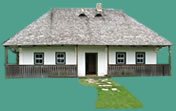The Paulencu Pioneer House
- Tour photo link
- Tour photo link
- Tour photo link
- Tour photo link
- Tour photo link
- Tour photo link
- Tour photo link
- Tour photo link
- Tour photo link
- Tour photo link
- Tour photo link
- Tour photo link
- Tour photo link
- Tour photo link
- Tour photo link
- Tour photo link
- Tour photo link
- Tour photo link
- Tour photo link
- Tour photo link
- Tour photo link
- Tour photo link
- Tour photo link
- Tour photo link
- Tour photo link
- Tour photo link
- Tour photo link
- Tour photo link
- Tour photo link
- Tour photo link
- Tour photo link
- Tour photo link
- Tour photo link
- Tour photo link
- Tour photo link
- Tour photo link
- Tour photo link
- Tour photo link
- Tour photo link
- Tour photo link
- Tour photo link
- Tour photo link
- Tour photo link
- Tour photo link
- Tour photo link
- Tour photo link
- Tour photo link
- Tour photo link
- Tour photo link
- Tour photo link
- Tour photo link
- Tour photo link
- Tour photo link
- Tour photo link
- Tour photo link
A Bucovinan Peasant Cottage in Rural Manitoba
The Paulencu House was constructed in 1906 by Ion Paulencu, seven years after his family's arrival in Canada from Voloca, a village in the Romanian province of Bucovina (at that time a part of the Austro-Hungarian Empire and presently in Ukraine).
It replicated the traditional peasant style of architecture of the Carpathian region of Bucovina and is the only known surviving example of a Bucovinian-style farm house in Manitoba and perhaps in all of North America. It features saddle-notch log construction, traditional clay and straw plastered walls, overlapping roof beams, a meat smoke house in the attic, eyebrow smoke vents in the roof and period furnishings.
The Paulencu house was restored in the 1990s following the guidelines of Heritage Manitoba and received the 2002 Manitoba Prix Award for Heritage.
Visiting the Paulencu house takes us back to the simplicity of a subsistence lifestyle that was shared by countless rural settlers in Canada well into the 20th century, while at the same time immersing us in the cultural heritage specific to the Romanian-Canadian immigrants from Bucovina.
SHELTER AND CULTURAL HERITAGE: All About the Paulencu House
1. From bordei to peasant cottage
The need for shelter was foremost in the minds of the new immigrants arriving in the Asessippi district of Manitoba from Bucovina. Their first shelters were usually one- or two-room log cabins, plastered with clay and covered with sod, called bordei in Romanian. When they became more prosperous, "second generation" dwellings were constructed, which were more elaborate in design and large enough to accommodate the growing families.
One such house was constructed by Ion Paulencu, a member of the original group of immigrants who arrived in the area in 1900. This primitive and rustic bordei had served the family until 1906, when they erected a second dwelling which was more substantial and roomy. It was based on the design of peasant cottages common to agricultural villages in the Carpathian Mountain region of Bucovina.
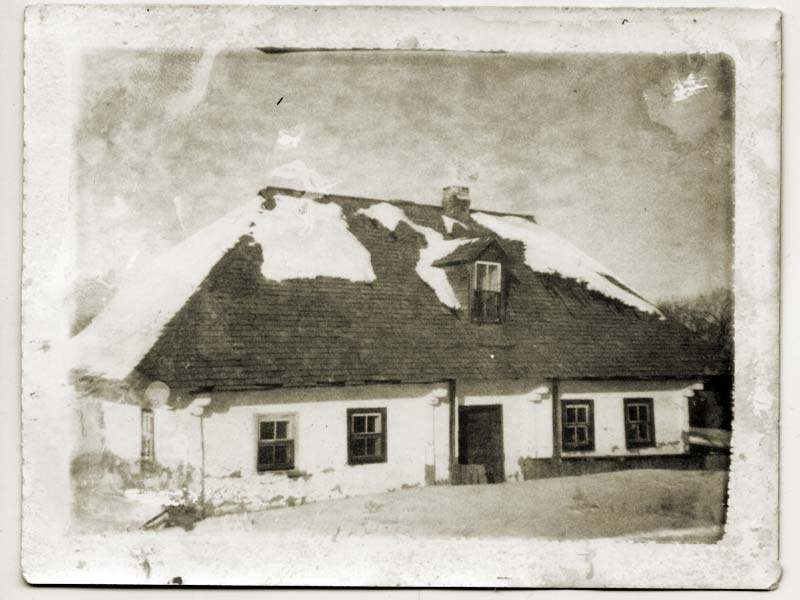 The replication of the Carpathian style in the house construction is a concrete example of how these immigrants from Bucovina sought to reproduce their cultural heritage in Canada. We can also see the influence of their imported peasant traditions in many of the objects in the house, which are home-made from available materials: benches, tables, door frames, hinges, latches and even tools. This is a reflection of how things worked in the subsistence economy they had left behind in Bucovina where they grew their own food and made, rather than purchased, the things they needed.
The replication of the Carpathian style in the house construction is a concrete example of how these immigrants from Bucovina sought to reproduce their cultural heritage in Canada. We can also see the influence of their imported peasant traditions in many of the objects in the house, which are home-made from available materials: benches, tables, door frames, hinges, latches and even tools. This is a reflection of how things worked in the subsistence economy they had left behind in Bucovina where they grew their own food and made, rather than purchased, the things they needed.
2. Construction Techniques
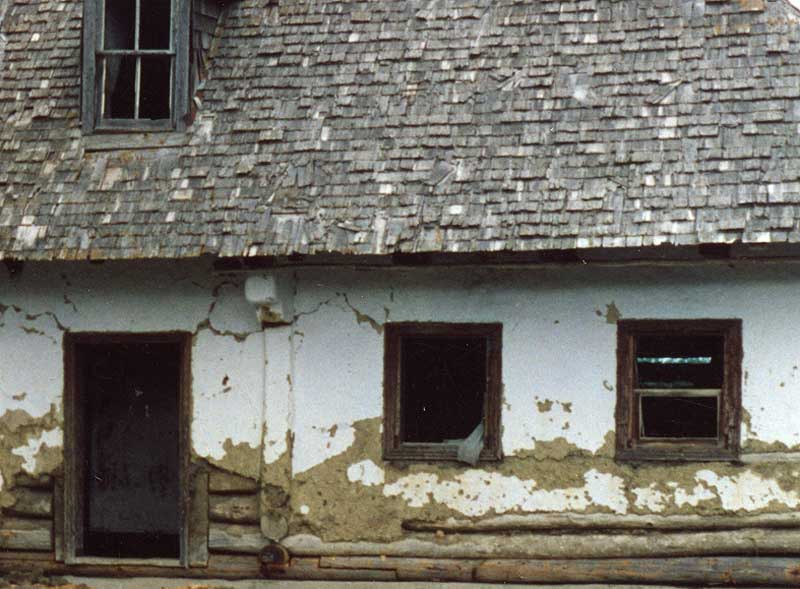 The walls of the house were constructed from logs obtained on the homestead property, and plastered with a clay and straw mixture. When dry, the interior and exterior walls were painted with white-wash or lime, as it was sometimes called. Large hand hewn beams supported the ceilings and roof. The ceiling beams extended beyond the outside walls, as did the roof. This overhang acted to protect the plastered walls from the elements and also used as a place to hang certain vegetables such as onions, corn and garlic after harvesting. Some houses, including the Paulencu house, had a fenced-in portico (or veranda) located beneath the extended roof.
The walls of the house were constructed from logs obtained on the homestead property, and plastered with a clay and straw mixture. When dry, the interior and exterior walls were painted with white-wash or lime, as it was sometimes called. Large hand hewn beams supported the ceilings and roof. The ceiling beams extended beyond the outside walls, as did the roof. This overhang acted to protect the plastered walls from the elements and also used as a place to hang certain vegetables such as onions, corn and garlic after harvesting. Some houses, including the Paulencu house, had a fenced-in portico (or veranda) located beneath the extended roof.
3. Inside the house
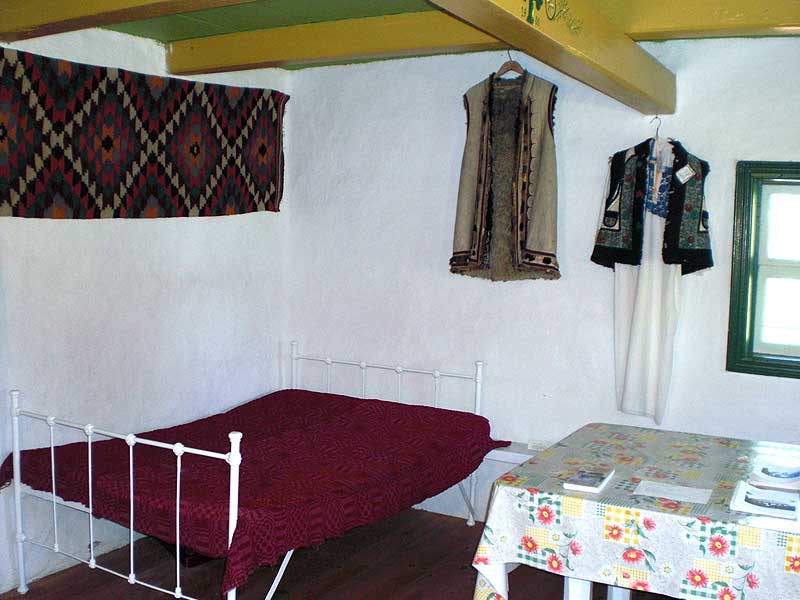 The house consisted of two large rooms on the ground floor, which were accessed from an entryway in the middle of the building. To the right was a larger room called casa ce mare in Romanian, which translates to “The Great Room.” Here was located a large table used mainly to entertain guests, and also where family members dined on special festivals, such as Christmas and Easter. In one corner was located a large bed on which the parents slept, and in another corner a hand-made cupboard for the more valuable family possessions and dishes. Several benches provided seating accommodation. A wood-burning space heater produced the heat required during cold winter months.
The house consisted of two large rooms on the ground floor, which were accessed from an entryway in the middle of the building. To the right was a larger room called casa ce mare in Romanian, which translates to “The Great Room.” Here was located a large table used mainly to entertain guests, and also where family members dined on special festivals, such as Christmas and Easter. In one corner was located a large bed on which the parents slept, and in another corner a hand-made cupboard for the more valuable family possessions and dishes. Several benches provided seating accommodation. A wood-burning space heater produced the heat required during cold winter months.
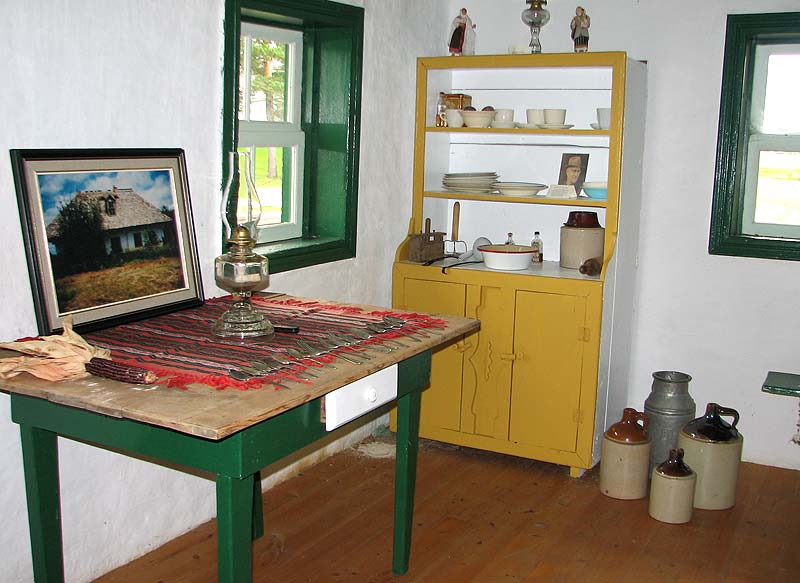 In the room to the left was the kitchen where the family normally ate their meals and spent most of their indoor time. Here was located a large wood-burning cook stove, a smaller table, a cupboard and benches. Often a small wooden bed would be installed in one corner to enable the exhausted house-wife to rest and for the young children to sleep until they became old enough to move upstairs. In the old country this bed was also used by the husband when he returned from a night at the local caesma (an inn where liquor was served). Other utensils, such as the spinning wheel and butter churn were also located in this room.
In the room to the left was the kitchen where the family normally ate their meals and spent most of their indoor time. Here was located a large wood-burning cook stove, a smaller table, a cupboard and benches. Often a small wooden bed would be installed in one corner to enable the exhausted house-wife to rest and for the young children to sleep until they became old enough to move upstairs. In the old country this bed was also used by the husband when he returned from a night at the local caesma (an inn where liquor was served). Other utensils, such as the spinning wheel and butter churn were also located in this room.
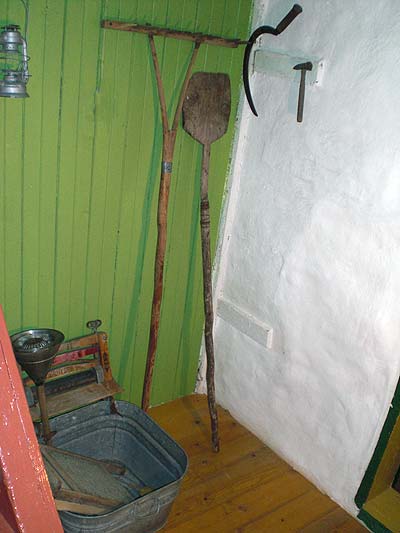
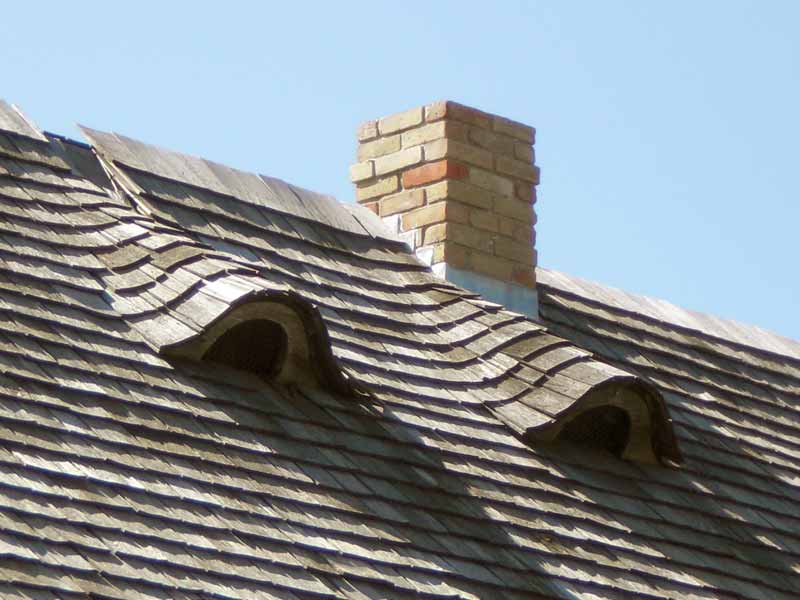
At the landing, at the bottom of the stairs leading to the second floor, was a small area where the wood box, tools, brooms, laundry tubs, and larger household utensils were stored. Upstairs in the Paulencu house a whole room was dedicated to storing food and smoking meat and fish. Here, smoke was captured by disconnecting the stove pipe running through the room and allowing the smoke to fill the area where meat and fish were hung on thin wooden rails suspended from the ceiling. Surplus smoke escaped through two eyebrow openings in the roof. When more children arrived in the Paulencu family, the upstairs area was divided into two rooms, one of which served as a bedroom for the children, and the other continued to be used as a smoke room.
4. Habitation and Restoration
From 1906 to the 1950s, the Paulencu house was used as a residence by the original family, and later by the descendents. It was abandoned around 1955 and lay exposed to the elements until the late 1980s. In that period the community mounted a campaign to move the house from its original location, a half mile south, to the church property where the St. Elijah Pioneer Church Museum was located. A generous former resident donated the money to hire a mover and transfer the derelict house to its new location.
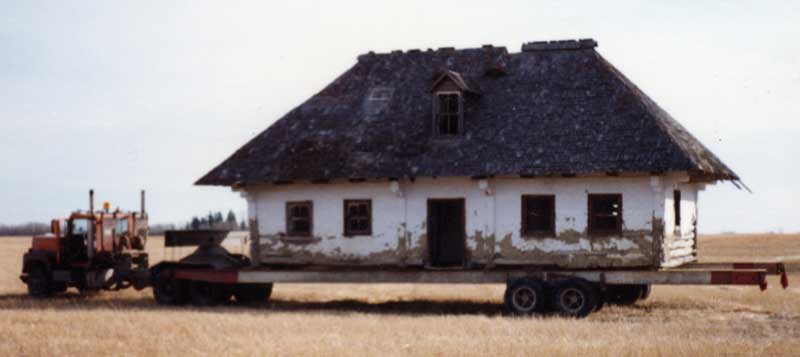 After the house was stripped of its crumbling plaster and the decaying parts, it was moved onto a concrete pad at the new location. Volunteers then replaced the removed pieces with identical materials which were either custom milled or obtained from salvage yards. Fortunately, the windows and doors were still well preserved and only needed minor restoration. The roof was shingled with custom-milled cedar shingles, and the chimney rebuilt.
After the house was stripped of its crumbling plaster and the decaying parts, it was moved onto a concrete pad at the new location. Volunteers then replaced the removed pieces with identical materials which were either custom milled or obtained from salvage yards. Fortunately, the windows and doors were still well preserved and only needed minor restoration. The roof was shingled with custom-milled cedar shingles, and the chimney rebuilt.
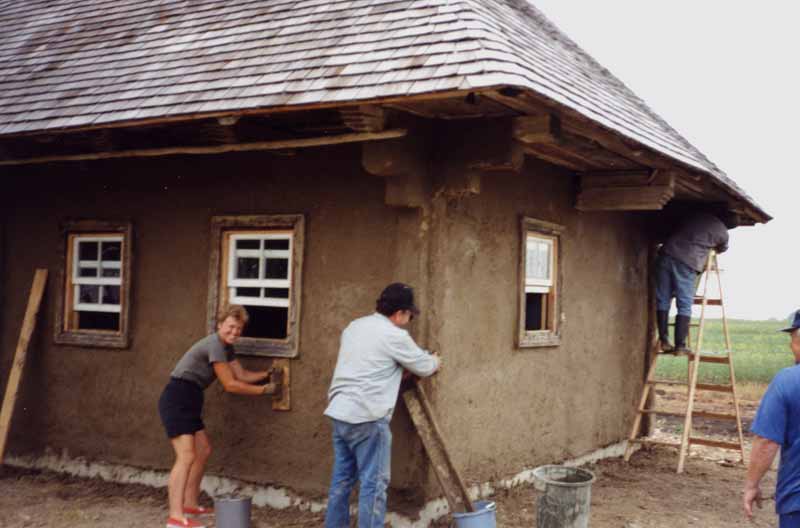 Then came the formidable task of re-plastering the whole building. This proved to be one of the most difficult and challenging parts of the whole project. Some of the volunteers had a basic idea of how to mix the materials and apply the plaster, but most had lost the finer knowledge and skills of their ancestors. Several applications were made only to later fall off the walls. After many valiant attempts with varying types of materials, preparations and application, a good mix was finally achieved. The problem of developing a mixture resembling white wash or lime for applying to the walls was solved after experimenting with several ingredients consisting of powdered white lime, mortar cement, and a bonding agent.
Then came the formidable task of re-plastering the whole building. This proved to be one of the most difficult and challenging parts of the whole project. Some of the volunteers had a basic idea of how to mix the materials and apply the plaster, but most had lost the finer knowledge and skills of their ancestors. Several applications were made only to later fall off the walls. After many valiant attempts with varying types of materials, preparations and application, a good mix was finally achieved. The problem of developing a mixture resembling white wash or lime for applying to the walls was solved after experimenting with several ingredients consisting of powdered white lime, mortar cement, and a bonding agent.
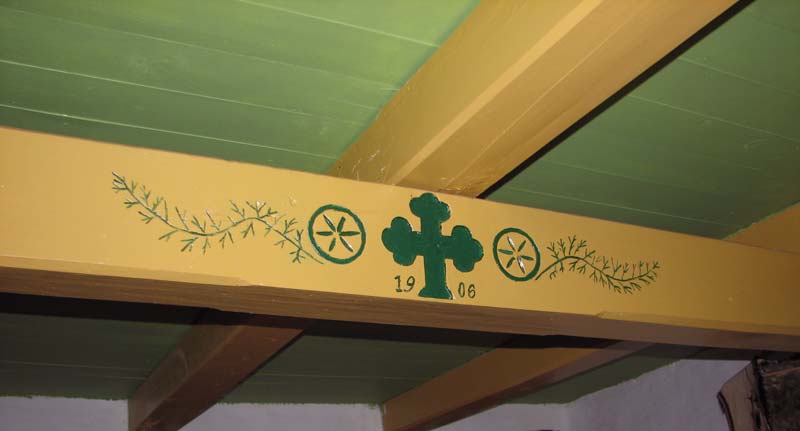 By 1998 the house was finally ready for final touches, such as painting the woodwork, and for furnishing the rooms. All the colours were replicated to match the original hues and the rooms were furnished with authentic pieces of furniture from that period, which were donated by descendents of the original pioneers.
By 1998 the house was finally ready for final touches, such as painting the woodwork, and for furnishing the rooms. All the colours were replicated to match the original hues and the rooms were furnished with authentic pieces of furniture from that period, which were donated by descendents of the original pioneers.
But one notices that even in this early pioneer home, there is evidence of adopting the ways of their new culture and economy. For example, over the years, many consumer goods were integrated into their lifestyle, purchased with money made from wage labour or selling surplus agricultural products such as butter, eggs and grain. From the enameled basin found in the washstand as we enter the house, to the tongue and groove milled lumber used in the ceilings, to the bed frames and mattresses, and the paint used to liven up their living space, we see how the pioneers adapted to and took advantage of what Canada had to offer them.
5. Other peasant cottages lost
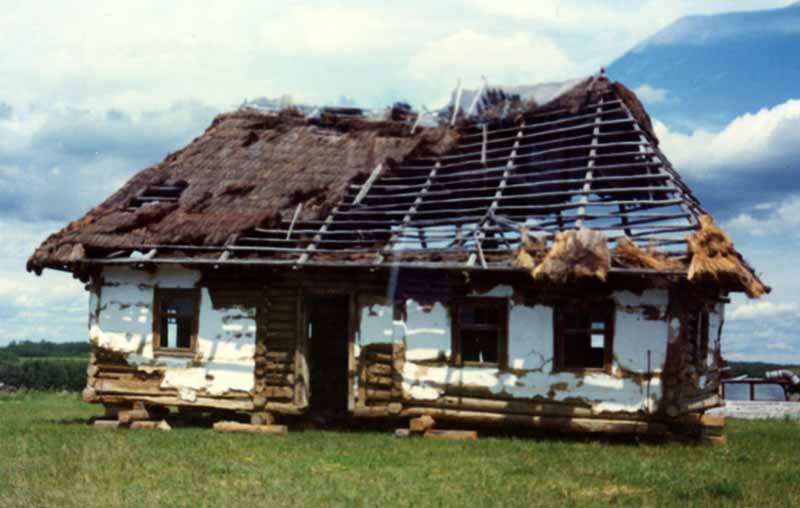 Between 1905 and 1915, several houses were constructed in the community resembling the restored Paulencu house. One of these was built by Vasile Iftody and another by Gheorghe Paulencu, both in the vicinity of the Lennard community. However, of all these, only the Paulencu house escaped demolition and remains as a silent reminder of that period more than 100 years ago. As the descendants of the original Bucovinian pioneers became more and more assimilated into mainstream culture, their place in the consumer economy would overshadow their subsistence origins, and their homes would reflect this change.
Between 1905 and 1915, several houses were constructed in the community resembling the restored Paulencu house. One of these was built by Vasile Iftody and another by Gheorghe Paulencu, both in the vicinity of the Lennard community. However, of all these, only the Paulencu house escaped demolition and remains as a silent reminder of that period more than 100 years ago. As the descendants of the original Bucovinian pioneers became more and more assimilated into mainstream culture, their place in the consumer economy would overshadow their subsistence origins, and their homes would reflect this change.
The Paulencu house is believed to be the only remaining specimen of this design in North America. Its development into a museum ensures that it will survive as an example of what life was like on the agricultural frontier in Manitoba more than a century ago. The project was supported financially by Manitoba Culture, Heritage and Tourism.
Find out more: consult historic photos and print documents related to the Paulencu House | take a visit in photos | see photos of the restoration
Links: Canada Historic Places listing | Manitoba Provincial Heritage Site No. 74 listing
